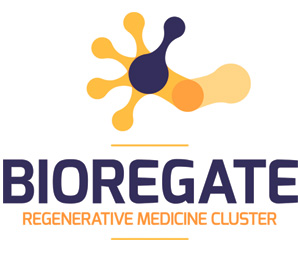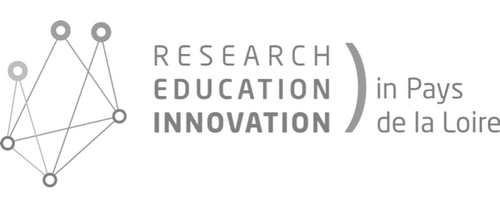Organization activities
The research laboratory “Protein Engineering and Functionality Unit” (UFIP) is a mixed research unit belonging to the University of Nantes and the CNRS. It was established on January 1st, 2012 for 2 years as FRE CNRS No.3478, and became UMR CNRS No.6286 on 1st of January 2014.
UFIP is located on the Science campus of the University of Nantes. This campus also hosts the chemistry and computer sciences CNRS laboratories, thus facilitating the activities of UFIP at the interface of chemistry and bioinformatics. It is also a member of the Federative Research Structure F. Bonamy (FED 4203 / UMS 016 Inserm / CNRS 3556), which federates all the research units in Health and Biology from the University of Nantes and coordinates their life sciences technological platforms.
UFIP is a unit that aimed to develop basic research in biology and in biotechnology. Its primary target was to investigate protein function and the modulation of their biological activities in relation to their interactions and their modifications namely through post-translational modifications or engineered mutations. Its activities also included the development of tools (in bioinformatics and biotechnology) in relation to these topics.
UFIP is organized in 4 teams
- Protein Design in Silico
- Molecular Engineering and Glycobiology
- Mechanism and regulation of DNA repair
- Epigenetics: Proliferation and differentiation
UFIP research activities
Protein Design in Silico
The two main goals of the Protein Design in Silico team are the following ones:
- To help interpreting experimental results obtained by the other teams of UFIP. For this purpose, standard modelisation methods and approaches are usually used (molecular dynamics simulations, protein-protein, protein-ligand docking, etc).
- To develop methods for studying the sequence-structure-dynamics-function relationship of proteins, focusing on recent and original approaches (normal mode analysis, structural alphabets…).
More specifically:
- Sequence-structure relationship: structural alphabets are developped, focusing noteworthy on the prediction of local and tertiary structures (the fold recognition problem).
- Structure-flexibility relationship: previous work on normal mode analysis is extended, focusing noteworthy on the production of ensembles of protein conformers able to recapitulate the ensembles that can be observed by nuclear magnetic resonance or in the course of long molecular dynamics simulations.
- Structure-function relationship: previous work on protein-oligosaccharide (in collaboration with the Glycobiology team) and protein-odorant complexes is extended. The protein-protein recognition issue is also addressed, within the frame of a large regional collaboration (the PIRAMID project).
Team leader: Y-H Sanejouand – yves-henri.sanejouand@univ-nantes.fr
Molecular Engineering and Glycobiology
The team develops new enzymatic and recognition tools for Glycobiology. The project relies on the use of original know-how at the chemistry/biology interface.
Chimio-enzymatic synthesis of oligosaccharides and glycoconjugates:
- Engineering of new transglycosidases : the team has developed innovative strategies for converting glycosidases into transglycosidases. Our main objective was to shed light on the structural and dynamic factors that control the transglycosylation / hydrolysis balance in the mechanism of the selected glycoside.
- We propose general approaches to enhance transglycosidase reaction over hydrolysis in several glycoside hydrolase families (α-glucosidases, α-galactosidases, α-fucosidases, α-arabinofuranosidases, sialidases, N-acetyl-glucosaminidases). Such engineered transglycosidases are evaluated for the synthesis of various oligosaccharides: sialylated and fucosylated human milk, parasitic antigens, prebiotics…)
Tools for sugar/protein interactions:
- Design of specific inhibitors of Galectins for further validation as therapeutic targets (sound-healing, arthritis diseases).
- Engineering of sugar binders (lectins, CBM, new protein scaffold) for targetting and diagnostic applications.
- Anti-infectious glycotechnology: Our efforts aim at improving glycoconjugate vaccines notably upon designing particulate vaccines for mucosal immunization (cholera, anthrax, pneumococcal infections)
Know-how:
- Protein engineering and directed evolution.
- Chemo-enzymatic synthesis.
- Bio-organic chemistry, bioconjugaison, glyco-chemistry
Team leader: Cyrille GRANDJEAN – cyrille.grandjean@univ-nantes.fr
Mechanism and regulation of DNA repair
Our main objective is to understand the molecular and biochemical mechanisms of DNA repair, including homologous recombination (HR), and to explore DNA repair pathways involved in the process of resistance to anticancer therapy..
We are interested in Rad51, a key protein to HR. This protein is frequently overexpressed in cancer cells and can lead to radio- and chemoresistance.
Interactions involving proteins of DNA repair are studied by high-throughput screening (protein chips). Characterization and structure-function analysis are also addressed by a set of biophysical tools. All these technologies, available through the IMPACT platform, are fully controlled by our team. Thus, the molecular information extracted could be used to better understand the regulation at the cellular level. This molecular-cellular interface is one of the strengths that characterize our team.
1. DNA repair by HR
Rad51 is a potential target that could be used in the fight against cancer. In this context, our team seeks to understand the molecular mechanism at the different stages of the recombinase activity and to develop Rad51 inhibitors. Recently, we proposed different types of inhibitors (peptide, nucleic aptamer and chemical molecule) some of which have been proved effective in vitro.
The improvement and the optimization of these inhibitors by molecular modeling recombinase (Team 3), lead us to evaluate these molecules at the cellular level and to confirm their efficacy against resistant cancer cells.
2. Regulation of repair pathways in response to DNA damage
In addition to studying recombinase activity modulations in vitro and in cellulo, a global analysis of the repair regulation of DNA damages is considered. Regulating Rad51 expression in/during the cell cycle is considered using Physarum polycephalum as a model system (Team 1). In parallel post-translational modifications, that are essential in the regulation of proteins involved in pathways of DNA repair, are studied. Rad51 may be directly phosphorylated by kinases like Abl or BCR-Abl, involved in cancer chemoresistance. However, relations with signaling pathways are not yet clearly established. We develop and create tools, i.e. specific antibody chip, to analyze the profiles of phosphoproteomic resistant cancer cells in order to identify activation pathways important for DNA repair. The effects and consequences of inhibitors on Rad51 activity are also analyzed and evaluated in the ways of DNA repair.
Team leader: Fabrice Fleury – fabrice.fleury@univ-nantes.fr
Epigenetics: Proliferation and differentiation
Our team is interested in the basic understanding of function and establishment of histone associated epigenetic signaling in cellular models. These epigenetic mechanisms are of conservative nature in eukaryotes and their dysfunction can lead to genetic program abnormalities. This point shows that the fields of applications of these epigenetic mechanisms knowledge could be vast, for example biomedicine, agronomy or more generally biotechs.
Team leader: Christophe Thiriet – christophe.thiriet@univ-nantes.fr

